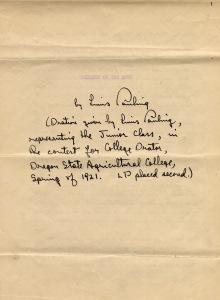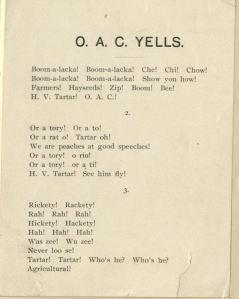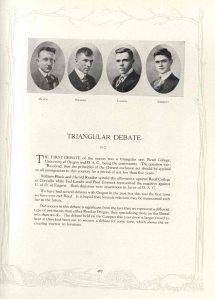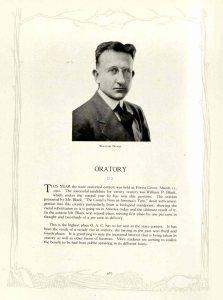
[Post 1 of 2 focusing on the culture of oratory at Oregon Agricultural College during Pauling’s undergraduate years.]
Early in the 20th century, Oregon Agricultural College (OAC) – the institution now known as Oregon State University – was in the midst of rapid expansion and development. As new buildings sprung up and the student population steadily increased, the college was gradually acquiring all the markings of a venerable institution.
Prior to 1920, however, one such marking was still missing: a speech department. Viewed through a contemporary lens, it may be difficult to imagine the extent to which colleges of Pauling’s era prioritized and emphasized their linguistics departments. It is nonetheless true that, through the first half of the 20th century, the presence of eloquent orators on campus was a symbol of an institution’s cultural status.
Indeed, the focus on both oratory and debate at O.A.C. was, at this time, at least equal to the campus’ focus on athletics, music or drama. The college’s Forensics Club was regularly featured in the annual Beaver yearbook, with several pages dedicated to narrating club competitions. Likewise, the Barometer, OAC’s student newspaper, would at times publish up to six columns reporting on oratorical competitions in a single issue of the paper.
Oratory was so widely followed and competitive that an insert in the 1907-1908 Rooter’s Club booklet featured a cheer specifically created for OAC’s orators. Finally, in 1920, OAC established a speech department for the first time and thus was able to prepare a forensics team than was stronger than ever before.

“O.A.C. Yells” included in the 1907-1908 Rooter’s Club book. Note the second cheer written specifically for competitors in speech competitions.
The new speech department was a major asset to the college in part because speeches were used for more than oratorical competitions; oratory was a convention used to enhance the experience of nearly all campus events. Orators, for instance, might address the general student body or the college’s athletes before an athletic event in order to raise confidence and excitement in competitors and spectators alike. As stated in The O.A.C. Alumnus, a 1920s publication of the college alumni association, “forensic men and women [gave] athletics every ounce of support” by delivering lengthy and spirited pep talks. Once the game had started, oratory was also used to engage in “verbal combat” with students from other institutions.

Beaver Yearbook page devoted to a “triangular debate” between OAC, Reed College and the University of Oregon. Paul Emmett is pictured at right.
The early 1920s coincided with Linus Pauling’s final years as an OAC student. Not surprisingly, his early experiences as a public speaker were heavily influenced by the high value that was placed on oratory within the student culture that surrounded him.
Even before entering any competitive event, Pauling had gained significant experience speaking to groups while teaching entry-level chemistry to fellow OAC undergraduates. During this same time period, Pauling’s close friend, Paul Emmett – later to become one of the world’s great catalysis chemists and, later still, Pauling’s brother-in-law – became quite active in the OAC Forensics Club and subsequently introduced Pauling to the thrills of competitive oratory. Emmett represented OAC in the 1920 triangular debate, an annual competition involving three colleges. The following year, both Emmett and Pauling were featured in the forensics section of The Beaver yearbook, Emmett as a debater and Pauling as a runner-up in the college-wide oratorical contest discussed below.
By founding a department dedicated to public speaking, OAC was able to provide members of its Forensics Club with a better training infrastructure. Importantly, Professor George Varney served as coach of the Forensics Club starting in 1920. Varney was a new arrival to the college but was known for having trained orators at different institutions, including a state champion. However, when Linus Pauling decided to compete in the annual inter-class oratorical contest, he sought the help of his own personal coach, an English professor whose past experience as a preacher qualified him to train students in the art of public speaking.

Pauling (bottom row, second from left) as depicted in the Beaver yearbook with fellow members of the class of ’22.
Competing for the Juniors in OAC’s inter-class speaking competition, Pauling presented a grand interpretation of the status and future of civilization in the 20th century. Titled “Children of the Dawn,” (which he meant to refer to members of his generation) Pauling’s speech contained both analysis of the past and speculation on the future.
The piece opens with a poetic description of a dream, one in which humanity and Earth are only specks within the greater universe. In Pauling’s dream, humanity had developed so effectively as to reach beyond Earth to understand the entire universe. This dream, Pauling reveals, is an allegory for the possibilities that he saw as lying ahead for his generation.
From there, the speech chronicles the development of science and thought since ancient times in order to demonstrate the talk’s main argument: that Darwin’s theory of evolution can be applied to society, science and civilization. In this, Pauling describes the developments of the past as necessary steps to completing a “Great Design,” by which he means an entire universe that is progressing in accordance with the principles of evolution.
Pauling’s optimism and use of poetic language makes for an inspiring oration. The speech concludes on an even more hopeful note by suggesting that the youth of the day were privy to only the germs of unimaginable achievements yet to come. “It is impossible for us to imagine what developments in science and invention will be witnessed by the next generation,” Pauling wrote. “We are not the flower of civilization. We are but the immature bud of a civilization yet to come.”

William Black
Impressive as Pauling’s first competitive oration was, he wound up tying for second place in the OAC competition, losing top honors to William Black, a senior and three-time participant in the event. Contrary to Pauling’s idealistic and relatively simple premise, Black’s oration, titled “Our Tottering Civilization,” presented an elaborate and frankly racist view of the times. Black’s main argument was that interactions with “peoples of color” would be the demise of civilization as a whole. Black further suggested that in order to safeguard its civilization, the white race needed to secure its natural resources and keep people of color at bay. Black likewise worried that European culture could be lost forever if other cultures were to gain further sway over world social, political and economic affairs.
At the time, China and Japan had undergone periods of rapid modernization and immigrants from east Asia were very well established as active participants in the U.S. economy. The arguments issued in “Our Tottering Civilization” largely stem from a fear that further development of these cultures, both in and beyond the United States, could eventually lead to the subjugation of Western ideals. Black’s oration concludes by exhorting white nations to join forces against the further development of “colored” nations. Despite the fact that Black’s speech is overtly racist, it eventually won second place in the state-wide intercollegiate oratory contest, perhaps because of the complexity of the issues that it dealt with, or maybe because Black was an especially compelling speaker in person.
This episode in Linus Pauling’s life, in which he battles for the crown of top college orator, offers an interesting glimpse into the culture of the early 20th century. While many elements of the era would appear almost foreign in a contemporary context, they do offer important evidence of the values and training that Pauling was exposed to long before becoming a world-renowned peace activist and public speaker. Next week we’ll examine another important talk that Pauling gave as an undergraduate; one that has special relevance to events happening right now on the OSU campus.
